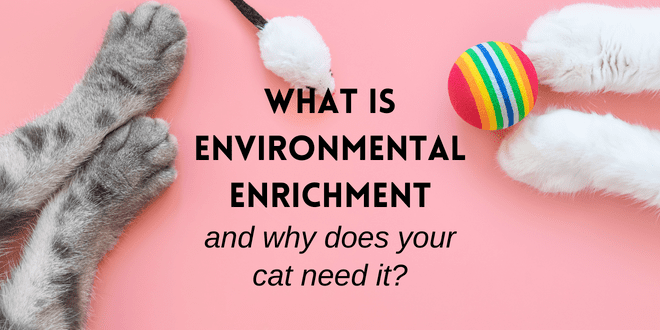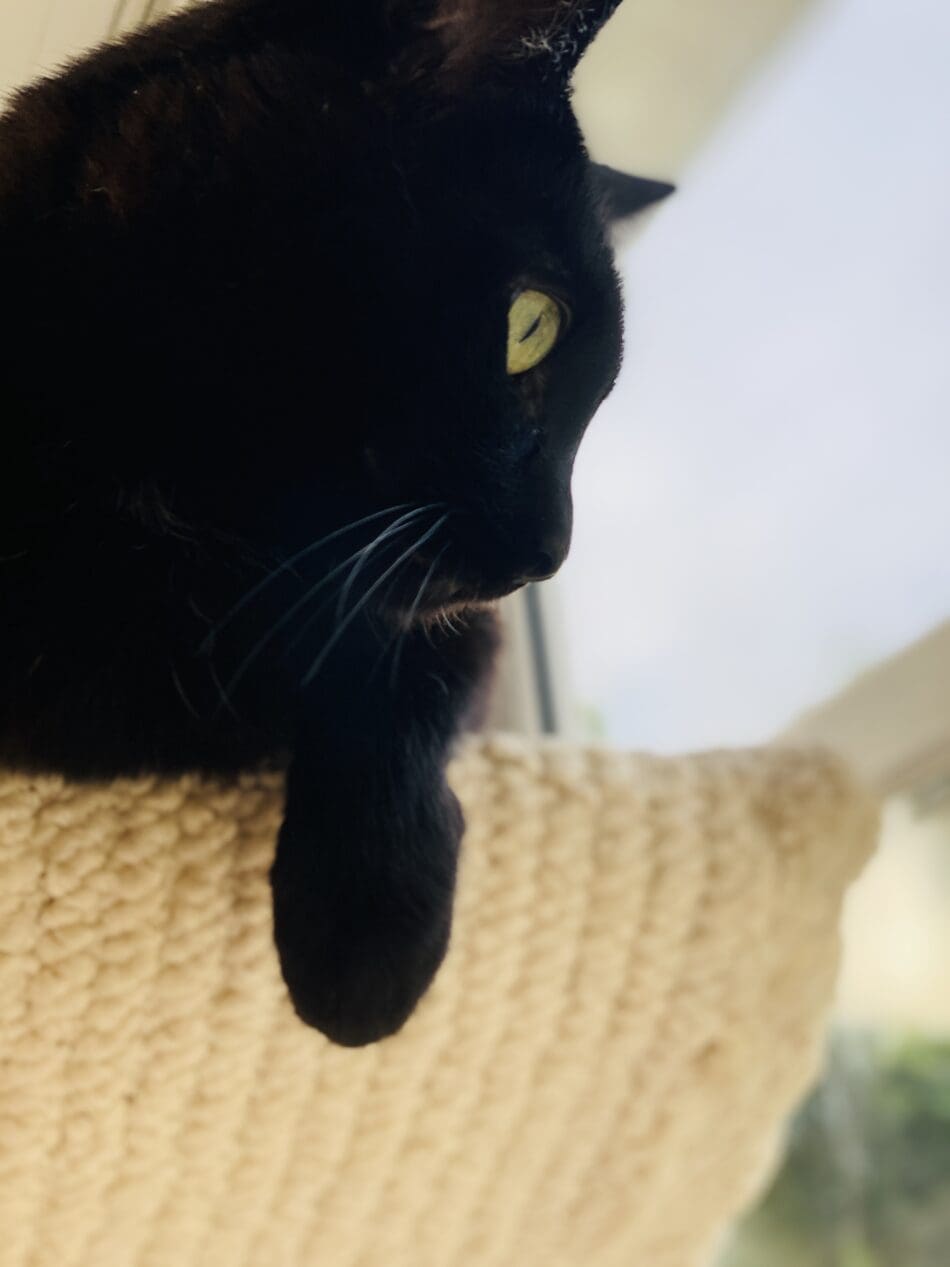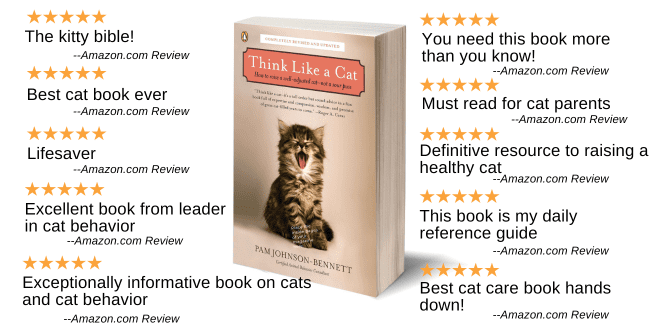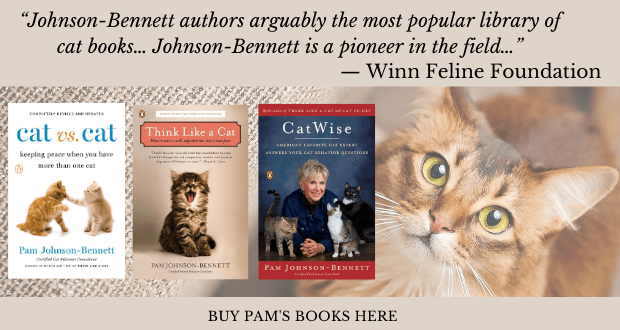
Environmental enrichment is a phrase that may not be familiar to you but it’s beneficial that you become familiar with it and what it means to your cat. A boring environment can contribute to problems such as destructive behavior, intercat aggression, depression, and anxiety. Under-stimulated cats are at risk of developing boredom-related or stress-relieving behaviors such as over-grooming, chewing inappropriate items, picking on companion pets, retreating into isolation, over-eating, self-mutilation, compulsive behavior and loss of appetite.
Environmental enrichment strengthens a cat’s living situation to encourage natural behaviors which help improve overall well-being.
Start With a Foundation of Health and Nutrition
It’s not the exciting part of enrichment but it’s essential. Environmental enrichment won’t mean anything if you aren’t keeping up on your cat’s veterinary care and maintaining their health, as well as providing proper nutrition.
Don’t skip veterinary exams. Cats are masters of hiding signs of pain and illness so even if you think your cat doesn’t need a check-up, don’t skip those yearly wellness exams. And, if your cat displays a change in behavior, litter box habits, appetite, or appearance, it could be a sign of an underlying medical issue. Time for a veterinary visit.
Your cat needs to be on a good quality nutritional program that’s appropriate for his age and health. If your cat is overweight, work with your veterinarian to determine what your cat’s ideal weight should be and how much food should be fed daily to slowly and safely reach that goal. Cats can’t be put on drastic diets because it puts them at risk of a serious liver condition.
So start your environmental enrichment program by staying on top of your cat’s health.

Photo: Pam Johnson-Bennett
Address Behavior Issues
Ok, I know we’re still not getting into the fun stuff yet but this is an important piece of the puzzle to enable your cat to fully enjoy the other aspects of enrichment. If there’s a behavior issue, work on identifying the underlying cause so you can address it. Remember, if there’s a behavior you don’t like, it’s not a result of your cat misbehaving. All behavior serves a purpose, even if you don’t like it. Behaviors are repeated because they work and make sense to the cat. To solve the problem, you have to figure out why the cat is displaying the behavior so you can provide a better option or change the setup so the cat no longer feels the need for the behavior. If you need help in identifying the cause, talk to your veterinarian to make sure there isn’t an underlying medical cause for the behavior. Your veterinarian may also provide a referral to a certified behavior professional.
Cats Were Born to Move
Cats have finely-tuned senses. The ears can move independently and hear sounds that humans can’t. Cats can pinpoint sound location with amazing accuracy. Their binocular vision has excellent low-light ability and can see in conditions humans consider totally dark. Then there’s a cat’s sense of smell. Odors can be detected that we’d never know where present. Cats have 200 million scent receptors compared to our 5 million.
Now let’s look at the cat’s body. Cats can jump 5-7 times their height. Cats walk on their toes for speed and stealth. They’re incredibly flexible and able to perform lightning-quick directional changes. Whiskers help navigate in dark environments and also help in detection of prey, among any other functions There are so many other facts about a cat’s body that enable them to have incredible speed, stealth and accuracy.
Imagine having all that equipment and it never gets used. That’s the way it is for many cats. They’re brought indoors (and we want them in indoors) but there’s nothing to do. Cats weren’t meant to be sedentary and eat mountains of food. Cats were born to move.
Why Environmental Enrichment Works for Cats
First, there’s physical health. If your cat is active he has a greater chance of staying in better shape. Those muscles get a good workout, the bones stay strong and the cat is more likely to maintain a normal, healthy appetite.
Now, let’s look at the benefits you may not be aware of. A cat who has positive experiences usually has more confidence and is better able to adjust to changes in life. Fun, safe environment = happy, confident cat. Stressful or boring environment = unhappy, stressed cat.
Since cats are sensory-driven, if a cat has no energy release, he may come up with one that isn’t beneficial. A common anxiety-relieving behavior is over-grooming. The cat may self-groom so much that bald spots appear. By providing outlets for energy release, the cat has something to do so he won’t need to engage in destructive behaviors.
When engaging in playtime, the brain chemical, dopamine, is released. Dopamine is related to eager anticipation. Opportunities to experience eager anticipation and exploration are important. Playtime, just as when hunting, provide emotional benefits to the cat. Luckily for us, cats can get all the emotional and physical benefits of hunting through playtime so we don’t have to worry about supplying mice or other live prey to keep our cats happy.
Implementing Environmental Enrichment
You can include food-related environmental enrichment whether you’re home or not through food-dispensing toys (aka puzzle feeders). A puzzle feeder in its basic form is simply a plastic ball with a hole in it where dry food randomly falls out as the cat rolls it around. Several manufacturers make a variety of ball-shaped puzzled feeders for dry food. I’m not a fan of dry food for cats as their only meal, but if you do feed dry food, this is at least a way to include enrichment and playtime instead of just dumping a mound of food into the bowl.
There are many other styles of puzzle feeders. Aikiou makes the Stimulo which is one of my cat’s favorites. This puzzle feeder uses tubes and the cat has to reach in to get the food. You can customize the length of the tubes to match your cat’s ability. The Stimulo is readily available through various online sites as well as at many local pet product stores. Another terrific company that makes puzzle feeders for cats and dogs is Nina Ottosson Products. Here a video from YouTube with cats “working” for food rewards.
You can also make homemade puzzle feeders by using plastic water bottles. Cut holes in them and place dry food or treats inside. Even the round cardboard insert from paper towels works well. Cut holes, put kibble in there and fold the ends closed.
The concept of working for food is natural for a hunter; they’re hard-wired to use their senses and physical skill to get prey. Batting a ball around provides activity and fun as opposed to hunkering down at an over-filled food bowl. The other benefit of puzzler feeders is that the cat will eat slowly.
If you feed wet food you can also set up puzzle feeders. Something as simple as a muffin tin can be a great wet food puzzle feeder. Put a drop of wet food in each compartment. For cats who eat too quickly, you can smoosh the food down a bit so they have to work a little harder for the reward. You can also put wet food in a mug placed on its side so the cat can use his paw to reach for it. Here’s a video from YouTube where a cat parent shows how she created simple wet food enrichment
Your Cat’s Playtime
Cats benefit from several types of play, including: interactive and object play. Interactive involves you holding a fishing pole-type toy so your cat can concentrate on being the hunter. Move the toy like prey so your cat can practice his hunting skills. To trigger the prey-drive move the toy across or away from the cat’s visual field. Don’t dangle the toy right in front of the cat. No self-respecting prey would run to the cat and offer itself up as lunch.
Playtime is also just as much mental as physical so when engaging in interactive play, don’t keep the toy in motion. Have it hide, quiver, dart across to another hiding place, etc. Put interactive toys away after playtime so kitty doesn’t chew stringed parts and to keep these sessions special.
Object play involves furry mice, crinkle balls and other small toys. Up the fun factor by placing them in objects or locations that inspire curiosity. Place a furry mouse inside an empty tissue box. Cut paw-sized holes in a box, tape the flaps closed and toss some toys in there. Place a ping pong ball inside a paper bag that’s on its side. Have a furry mouse peeking out from the top perch of a cat tree.
Your Cat’s Vertical Space
We live in a horizontal world but cats live in a vertical world. Cats often seek out high spots for napping. An elevated location can also become security for a cat, especially in a multicat home. The more vertical space, the more territory the cats have to share. If there’s tension between the cats, one kitty may climb to an elevated spot as a display of status. This can often be the display a cat uses instead of physical confrontation. An elevated spot can also be a refuge for a timid cat. the cat knows he’s safe there because no one can sneak up from behind
You can create vertical space with a cat tree. Manufacturers make trees in various heights and configurations. Depending on your budget you can purchase a simple tree or an elaborate one that reaches the ceiling. What’s most important is that it’s sturdy so if kitty takes a flying leap the tree won’t topple over. “U” shaped perches are better than flat ones because cats feel more secure when they can feel their backs up against something. If you do decide to get a tree with flat perches, just make sure they’re large enough to fit the size of your cat.
Cat walks, cat stairs, and cat shelves can add to vertical territory. You can purchase shelves and walkways or you can make your own. You can also install kitty stairs on the walls for the cats to access various shelves and perches. You can make it as elaborate or as simple as you want. In a multicat home, make two sets so one cat never blocks another cat from getting up or down. Avoid creating dead-end situations when installing vertical territory in a multicat home.
Window perches are great middle ground options. You can buy perches that attach to windows. Some have heating elements and that’s great for winter days where there might be a draft coming in or for older cats who need warmth.
Cats Need Hideaways
Hideaways can be in the form of an “A” frame, cave style, or donut-shaped bed. You can even take a box and turn it on its side to make a bed. Line it with a soft towel for your cat’s comfort. For a very timid cat, cut a hole in the box as an entrance, turn the box upside down and your cat will have a complete hideaway.

Photo: Pam Johnson-Bennett
No matter how confident your cat may be, always make sure there are options for hiding in the environment. Every cat needs hiding places. Hiding is a valuable component of enrichment because it serves as a stress-coping mechanism. The cat gets to remain “invisible” and might feel safe enough to remain in a room with others rather than run and hide under the bed.
Tunnels for Cats
A tunnel can be a wonderful addition to environmental enrichment. You can purchase soft fabric tunnels or make your own using paper bags. If using paper bags, fold a one-inch cuff at the top to make the bags sturdy. Cut the bottoms of the paper bags, fold a cuff around that end and then tape bags together. If making a long tunnel, cute a peek hole halfway through.

Photo: Pam Johnson-Bennett
Feeding Stations
The feeding station should be a place of security, comfort, and calm. Don’t feed in areas where there’s a lot of household traffic. Use a food bowl that’s shallow so it doesn’t squish your cat’s whiskers. A shallow bowl also allows the cat to eat while maintaining visual ability of their surroundings. This is especially essential in a multicat home.
In a multicat home, give each cat their own food bowl. Community bowls can inspire bullying. Additionally, don’t use double feeders with food in one side and water in the other. Food particles can get into the water and make the taste unpleasant. Keep food and water bowls clean and replenish the water bowl with fresh water every day. Locate the water bowl a little distance from the food. Many cats prefer to not have their water source so close to the food. To encourage your cat to stay hydrated, place water bowls in several areas around the house.
Water can be used for enrichment as well. Instead of a plain water bowl, consider using a pet water fountain. This is a good option for cats who like to overturn their water bowls in fun. There are many styles of water fountains so you can choose based on your cat’s personality. Some fountains provide a running stream, some bubble up from the center, and some resemble the motion of a dripping faucet.
Litter Box and Scratching Post
Part of creating a healthy environment involves a litter box set-up that is clean, the right sized box, and put in a location that’s appealing to the cat. Don’t drop the ball when it comes to your responsibilities for litter box maintenance. In a multicat household, locate litter boxes in each cat’s preferred area so one cat doesn’t have to cross another cat’s turf when it’s time to eliminate. Also, in a multicat home, the general rule of thumb is to have the litter boxes outnumber the cats by at least one.
If kitty is scratching the furniture it probably means he doesn’t have access to the right post. Scratching is a natural and beneficial behavior. Supply a tall, sturdy post that’s covered in a rough material such as sisal. Being able to get a good scratch, stretch the muscles and displace anxiety by scratching is a vital part of cat life. Find the right kind of post for your cat and place it in the area where he likes to scratch. Don’t hide the post off in a distant room where nobody goes. Scratching posts should be located in socially significant areas of the home.
Some cats like to scratch horizontally, so in that case, supply a corrugated cardboard scratch pad or a sisal scratch pad. If your cat likes to scratch on an incline, there are corrugated cardboard scratchers designed for that as well.
Sensory Enrichment for Cats
Visual enrichment. Check out YouTube for videos made for cats that showcase birds, and other prey. Between the visuals and the sound effects, many cats become fascinated. It can be a great way to entertain your cat or jump-start a play session. Even though the video enrichment is great, be sure to provide your cat with the opportunity to act on that fun through interactive playtime.

Photo: Pam Johnson-Bennett
Outdoor bird feeders can be very entertaining. Set one up near the window where kitty has a perch or cat tree. Ensure the feeders are set up where other neighborhood cats can’t come in the yard so you don’t upset your own cat.
Scent enrichment. Provide olfactory enrichment by offering catnip or silver vine a coupe times a week to your adult cat. It can be a great way to spark playtime. Buy good quality catnip or silver vine and keep it tightly sealed in a container.
Create other opportunities for your cat to enjoy novel scents as well as textures. In the fall I bring in leaves for my cat to enjoy. My cat loves the scent, crackling sound, and texture. In winter I bring in snow and in spring and summer I bring in blades of grass (untreated with pesticides or fertilizers). Bird feathers are another great option (wash before giving to the cat).
Touch enrichment. Cats can have texture preferences when it comes to toys so do some experimenting to see if your cat prefers toys with a crinkly texture like Mylar, or maybe a life-like fur texture, feather texture, or a smooth plastic feel. You can even mix it up so your cat gets the benefit of different textured toys. In a multicat home, you may find different cats have very specific texture preferences as well as play style preferences so pay attention to that so you can maximum playtime fun.
Sound enrichment. Your cat may enjoy hearing the birds chirp while watching YouTube, or you can use a sound machine that includes the sounds of birds. Music can also be beneficial for calming and stress-relief. Soft classical or new age music played periodically may help calm your cat. There’s even bioacoustic music created just for cats to help with calming. You can find it online.
Sound enrichment even applies to the type of toys you use for playtime. You may find your cat enjoys toys that make a realistic squeak or an irresistible crinkly sound when touched. Pay attention to how your cat reacts to see if there are any sound preferences.
Cats Can Enjoy the Outdoors Safely!
There are companies that make cat enclosures, commonly referred to as catios. Make sure the enclosure is well-constructed and sturdy. You can find lots of inspiration for outdoor enclosure designs online.
Clicker Training and Agility With Cats
Clicker training is effective and fun. A clicker makes a cricket-type sound and once the cat makes the association that the sound means a food reward will follow, you can use the clicker to “mark” positive behaviors. The clicker becomes the bridge between a behavior and the reward. I use clicker training in my consultations for behavior training but you can also use it to teach tricks. Clicker training gives the cat a job to do and he knows he’ll be rewarded with a treat. It’s a wonderful form of enrichment combined with training.
Agility is something we associate with dogs but cats can do it too. You don’t have to enter an agility competition but you can clicker train kitty to a fun obstacle course in your home. You can make it as basic as holding an embroidery hoop low to the ground with one hand while you hold a treat with the other to lure your cat to walk through. When the cat routinely walks through the hoop, continue the training but raise the hoop a little so eventually the cat is jumping through it. You can also use tunnels and even small jumps in your agility course. Make the whole process fun and if your cat isn’t enjoying it, don’t force the issue. Not every cat will want to do agility.
Feline Companionship
Cats are social, despite what you may have been led to believe. Their social structure is centered around resource availability. If you spend lots of time away from home, your cat might benefit from a kitty companion. After a gradual and positive introduction, having a buddy may make a huge difference when it comes to enriching a cat’s life.
No More Boredom for Your Cat
Environmental enrichment is a necessity and not a luxury. It’s time to increase the fun factor in your cat’s life. Customize whatever you do to fit your cat’s age, mobility, and health factors. Some cats will obviously be more active than others but every cat can benefit from a more stimulating environment and appropriate enrichment.
Need More Information?
For more specific information on cat behavior and training, or to learn more about enrichment, check out the best-selling books by Pam Johnson-Bennett. Pam’s books are available at bookstores and online. We’ve also included Amazon links here on our website.
If you have a question regarding your cat’s health, please contact your veterinarian. This article is not intended as a replacement for your cat’s veterinary care.
 Problem Solving & Advice by Pam Johnson-Bennett Cat Behavior Expert & Best-selling Author
Problem Solving & Advice by Pam Johnson-Bennett Cat Behavior Expert & Best-selling Author







